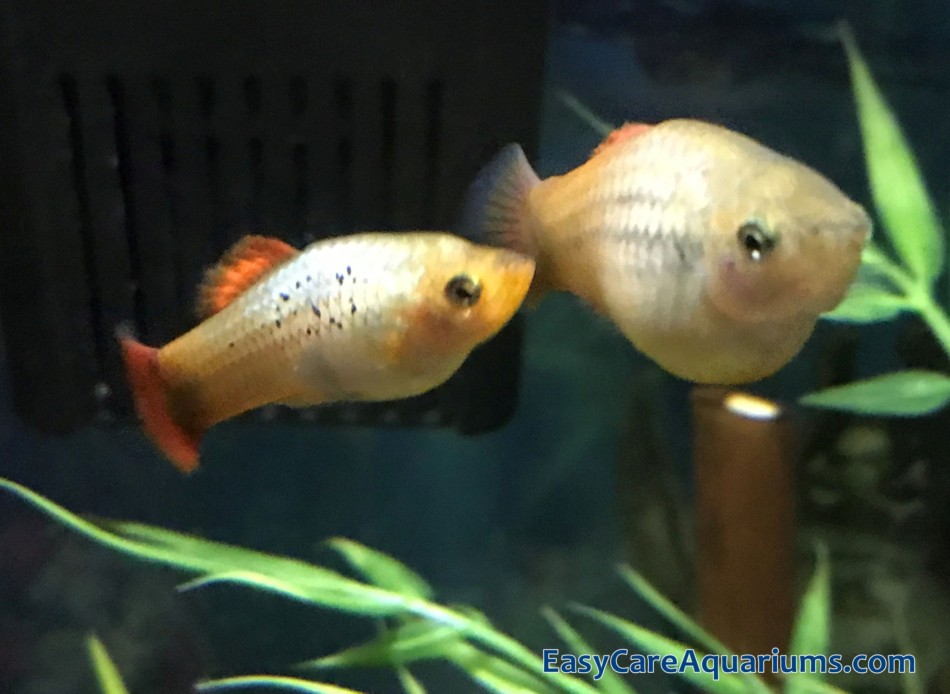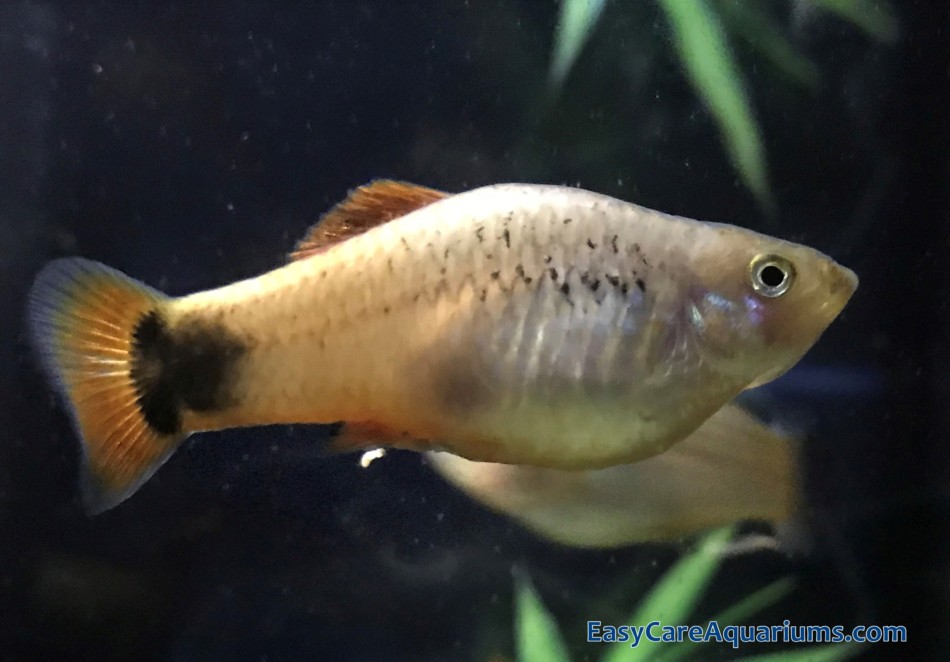This article may contain some affiliate links to products. The links provide me a small percentage of commission but do not cost you anything extra to use. (See full disclosure statement here ).
).
I adopted my Platy fish from my son. He has a large community tank and his Platys decided to increase the population of the aquarium. Being new to fish keeping myself I just assumed that Platys reproduce by laying eggs. Until I did a bit of research I didn’t realise that the Platy fish is a livebearer and they don’t lay eggs at all. So how do Platy fish breed?
Platy fish certainly don’t need any encouragement to breed. As long as their environment and diet are healthy they will reproduce. Platys are livebearers. Which means that the female Platy gives birth to live young (fry) rather than laying eggs. The Platy’s breeding process is quite simple. The male Platy releases gametes (sperm) through his gonopodium, which is his stick-like anal fin. The gametes are directed towards the inside of the female Platy’s anal fins. She then takes the gametes into her body to start the reproduction process. But when is all this likely to begin? And how will you know that your female Platy is pregnant?
Platy Fish Breeding Age
A Platy’s lifespan in a well maintained aquarium varies between 3-5 years. Probably nearer the 3 than the 5. Though you never can tell. Having so little time available to multiply is probably one of the reasons that the Platy starts to breed at an early age. Or maybe it’s just the way they are.
Whatever the reason for the early start they begin breeding as soon as they are mature enough.
A Platy fish reaches sexual maturity at around 4 months old. It’s also around this time that it becomes easier to tell the difference between a male and a female Platy. Which is useful to know, whether you want to breed them, or you would rather not.
So at around 4 months old your Platys will start to get the urge to mate. This urge is strong with Platy fish. Apart from swimming, eating and pooping it’s their only other pastime. And it definitely seems to be their favourite one!

Platy Fish Mating Behaviour
How are you going to know that your Platys are gearing up to become parents to lots of little baby Platys?
If you spend some time each day watching your fish you’re likely to spot some changes in their behaviour. Spending regular time watching them is a good way to spot illness or distress in your fish. And it’s also a great way to spot Platy mating rituals too.
The male Platy isn’t very subtle in his mating behaviour. In fact, he can become quite aggressive in the way he goes about trying to get the attention of a female Platy. The aggressive way that a male Platy behaves when he wants to mate is one of the main reasons that getting your aquarium male to female ratio right is important. 1 male to preferably 3 females is best.
When it comes to mating behaviour you’re likely to notice a few things. The male Platy’s idea of courtship involves a lot of chasing, pushing, nudging and generally pestering the female. In addition to all that you’ll also notice your male Platy rubbing up alongside the female. Now I know this doesn’t sound romantic, and it’s not, it’s just the way they do things. If you’re a female Platy it’s just a normal part of procreation.
And the thing that fascinates me most is the synchronised swimming bit. Well, at least that’s what it looks like to me. A male Platy will shadow a female Platy’s every movement around the tank. It’s actually a beautiful thing to watch. It’s like they’ve been practicing for months to put on a synchronised display just for you.
How Can You Tell If Your Platy Fish Is Pregnant?
A pregnant female Platy usually behaves perfectly normally. Which means you need to look out for physical rather than behavioural signs to tell if your Platy is pregnant.
So what signs are there to look out for that tell you that your Platy fish is pregnant?
When we think of pregnancy the first thing that springs to mind is a swollen belly. After all, room needs to be made for offspring to grow. And it’s no different with the Platy fish. A pregnant female Platy will develop a swollen tummy, which is often angular in shape rather than just rounded out.
Another sign that your female Platy is pregnant is that she develops a dark spot on her abdomen. The part of her abdomen that’s nearer to the anal fin. This is called a gravid spot. It’s not always possible to see the gravid spot if your Platy is dark in colour, but it’s there nonetheless.
Platy Fish Gravid Spot
The gravid spot on a platy fish is a sure indication that your female Platy is pregnant. The reason for this is that the dark colouration of the gravid spot is caused by the developing Platy babies (fry). The bigger the fry grow – the larger and darker the gravid spot gets. As the fry get nearer to being born, and are pushing against the inner wall of the abdomen, it’s sometimes possible to see the eyes of the fry if mummy Platy is pale in colour.
How Long Are Platy Fish Pregnant For?
If you’ve spotted signs that your female Platy is pregnant the next question you’re likely to ask yourself is, ‘When will my Platy fish give birth?’ The answer to which can help you to prepare for your new arrivals.
The simple answer is that the Platy’s gestation period lasts for between 24-30 days.
Judging when the birth will be can be a little tricky though. This is when spending time watching your fish each day reaps one of its many benefits.
One way to judge the approximate day that the fry will be born (it’s never going to be an exact calculation) is to note the date that you first see the gravid spot. Then count 24- 30 days. The fry are likely to be born within this time frame. But as I say, it can be hard to judge it precisely. Particularly if your Platy is so dark in colour that you can’t see the gravid spot.
Another thing to look out for is a change in shape of the abdomen. It not only swells up but it ‘squares off’ as the female nears the birthing time. Squaring off looks exactly the way it sounds. The belly changes from an enlarged rounded shape to a more square shape.
You will probably also notice a change in the behaviour in your pregnant female Platy. She will start to isolate herself from the rest of the fish in your aquarium. She’s not being antisocial. She’s just looking for a quiet spot to rest undisturbed. And at the same time she’s finding a place that she feels is safe to give birth to her babies in.
So even if the gravid spot isn’t visible due to your Platy’s colouring, there are other things to look out for that indicate that labour is imminent.

How Do Platy Fish Give Birth?
Because the Platy fish is a livebearer the female Platy gives birth to fully formed live young (fry).
When the time is right the pregnant female finds herself a quiet, secluded part of the tank. She’s in no mood to be disturbed at this point. So she does her best to hide away out of sight of the other fish in the tank. And it’s here, in the quiet space, that she starts the process of bringing her babies out into the world..
The pregnant female delivers her baby Platys tail-fin first. The fry wriggle their way into the water one at a time. Often in quick succession. Although there may be a short delay between some of the emerging fry.
You do need to be aware that Platy’s don’t have a protective instinct when it comes to their fry. Or anyone else’s fry for that matter. So the other fish in the aquarium are likely to see the fry as a tasty snack. And it’s not just the other fish that will eat the fry. Even the mummy Platy may feast on her newly born offspring. I know this sounds rather nasty but it’s just the way that Platy fish are.
However, the fry do have a defence mechanism against being eaten as soon as they are born. They are born ready to swim away. So it’s important for you to have lots of hiding places in your aquarium for them to hide in if you want to save at least some of your baby Platy fish.

How To Save Platy Fry
To give the fry the best chance of survival the hiding places need to be small. Too small for the bigger Platys and other adult fish to get into.
You can create hiding places in different ways. Dense leafy plants, whether live or soft artificial ones, make great places for the fry to hide in. You can use a combination of static and floating plants in your aquarium. Also both artificial and live grass or moss will make useful hidey holes for the fry.
You can remove the fry to a separate tank if you prefer. Or fit a breeder box/hatchery into the tank at the top. It’s not advisable to put the pregnant female in the box though, as she will get distressed and may miscarry her young. But these boxes are another way to keep your fry safe until they are big enough to be introduced back into the main tank.
It’s up to you how you do it but it’s worth remembering that you need to be prepared if you want to save as many fry as possible. You also have the option of leaving things to nature and seeing how many baby Platys you end up with over time.
Platy Fish Number Of Fry?
Just how many baby Platy fish can you expect to be born once your female Platy is pregnant?
Well it’s a staggering amount. Especially if you weren’t planning to breed your Platys! The female Platy can give birth to approximately anywhere between 8-20 fry at a time. Sometimes even up to 40 or more at a time. You can see now why I said approximately. Because with the Platy you never can tell how many babies are likely to appear. And the fry can be born on an almost monthly basis too. So if your female(s) reproduce regularly that’s a lot of baby Platys to deal with.
The amount of fry born will depend on the female herself and the size and quality of the aquarium environment. I have been told that female Platys won’t breed in overcrowded or poorly kept aquariums.
But because the Platy is a prolific breeder there really is no guarantee of that.


